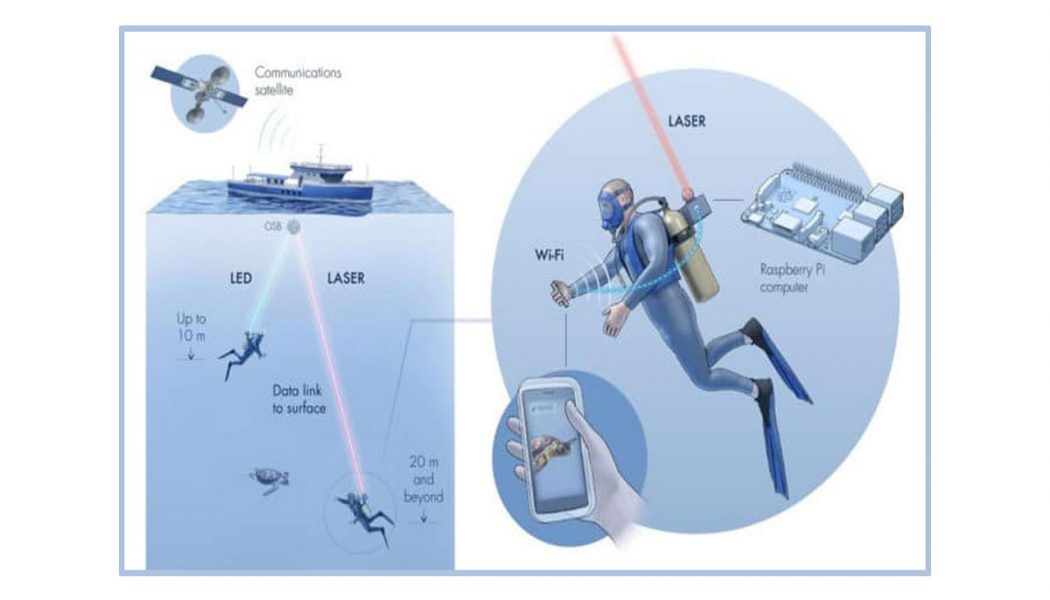Divers when underwater, may face many issues communicating with the rest of the team members or outside world. Sometimes their oxygen tank gets empty or some equipment malfunction and they are exposed to dangerous situations. The communication at present is mainly in three ways. The first method is by using a Transceiver, a wireless device allowing the divers to communicate verbally. The voice may not be always clear and sometimes, they may lose the device. The second mode is using something called Dive Slate similar to a Whiteboard. They write on it using a wax pencil attached to the slate. There are few variations of the Dive Slate. It may not be easy to read them underwater and they may also be lost. The third and most common is to use Hand Signals to communicate. There are certain Diving Signs that are commonly used to communicate. But what if they have to communicate with the surface team or would like to send some pictures instantly? Here comes, the future, the Aqua-Fi technology.
We know how much the Internet Technology has advanced and changed the total communication scenario. Internet has also become useful underwater with Aqua-Fi, the first underwater WiFi technology. Aqua-Fi system brings Internet to the underwater environment, to use the WiFi under the sea. Researchers at King Abdullah University of Science and Technology in Saudi Arabia have done research and presented the Aqua-Fi, the first underwater WiFi system enabling one to send and receive data online while underwater. The divers will be able to communicate between themselves or to the surface. It employs a low power underwater optical wireless system.
The Aqua-Fi prototype uses a LED or a Laser to support wide-range two way communication services. The LEDs are low power devices which can be used for short-distance solutions. Lasers extend the communication distance as well as the transmission rate but require more power compared to LEDs. The team led by Basem Shihada at King Abdulla University of Science and Technology built the Aqua-Fi system.
Their system uses green LEDs or Laser beam (520 nanometer) to send data from a small computer (Raspberry Pi Computer) to a light detector connected to another computer. The first computer converts photos and videos to binary (series of 0’s and 1’s) image, which are then translated to flashing light beams (on and off) at very high speeds. The light detector on the other computer senses this light and converts them back to the original image.
Right now, they are able to communicate only at short-distance but research is going on to extend the limit and make it available publicly. They could manage to get a data transfer speed of 2.11 MB per second with an average delay of 1.00 milliseconds for a round trip.
Shihada says –
“This is the first time anyone has used the internet underwater completely wirelessly”.
“We have created a relatively cheap and flexible way to connect underwater environments to the global internet. We hope that one day, Aqua-Fi will be as widely used underwater as WiFi is above water”.
“In the real world, Aqua-Fi would use radio waves to send data from a diver’s smartphone to a “gateway” device attached to their gear. Then, much like a booster that extends the WiFi range of a household internet router, this gateway sends the data via a light beam to a computer at the surface that is connected to the internet via satellite.”
“Aqua-Fi will not be available until we overcome several obstacles. We hope to improve the link quality and the transmission range with faster electronic components. The light beam must also remain perfectly aligned with the receiver in moving waters, and the team is considering a spherical receiver that can capture light from all angles.”
Reference: https://www.techexplorist.com
Journal Reference:
Basem Shihada et al. Aqua-Fi: Delivering Internet Underwater Using Wireless Optical Networks. DOI: IEEE Xplore
Pin it for later
